11.2: Introduction and Figures
- Last updated
- Save as PDF
- Page ID
- 34249
Analysis and interpretation of inscribed objects often focus on their written meanings and thus their status as products of completed action. Attention is less commonly directed to the ways in which past actors intermingled and transformed material substances via particular tools and embodied behaviours — the material practices which give rise to graphical expression and anchor subsequent acts of symbolic meaning (re-)construction. Building on research into the materiality of early writing and related image making (see Piquette 2007; 2008), this chapter focusses on one aspect of written object ‘life histories’ — the processes of remaking and unmaking. I explore below the dynamic unfolding and reformulation of ‘writing’ and related imagery as artefact within the context of a selection of early inscribed objects from the lower Nile Valley (Figure 1). The more portable writing surfaces include over 4000 objects, including small labels, ceramic and stone vessels, stelae, seals and seal impressions, implements, and personal items (Regulski 2010: 6, 242). The geographically- and temporally-related marks on fixed stone surfaces (variously referred to as ‘petroglyphs’, ‘rock art’, ‘rock inscriptions’ or ‘graffiti’, e.g. Redford and Redford 1989; Storemyr 2009) also constitute a crucial dataset for questions of early writing and image-making practices in north-east Africa, but fall outside the scope of this chapter. For its basis, this inquiry examines comparatively three inscribed find types: small perforated plaques or ‘labels’ of bone, ivory and wood; stone vessels; and stone stelae. Archaeologically, most are associated with large richly-equipped tomb complexes. I briefly touch on finds dating to the Late Predynastic (c.3300 / c.3200–3100 BCE), before turning to examples of written culture from the first half of the Early Dynastic Period (c.3100–2800 / 2770 bce; Table 1).
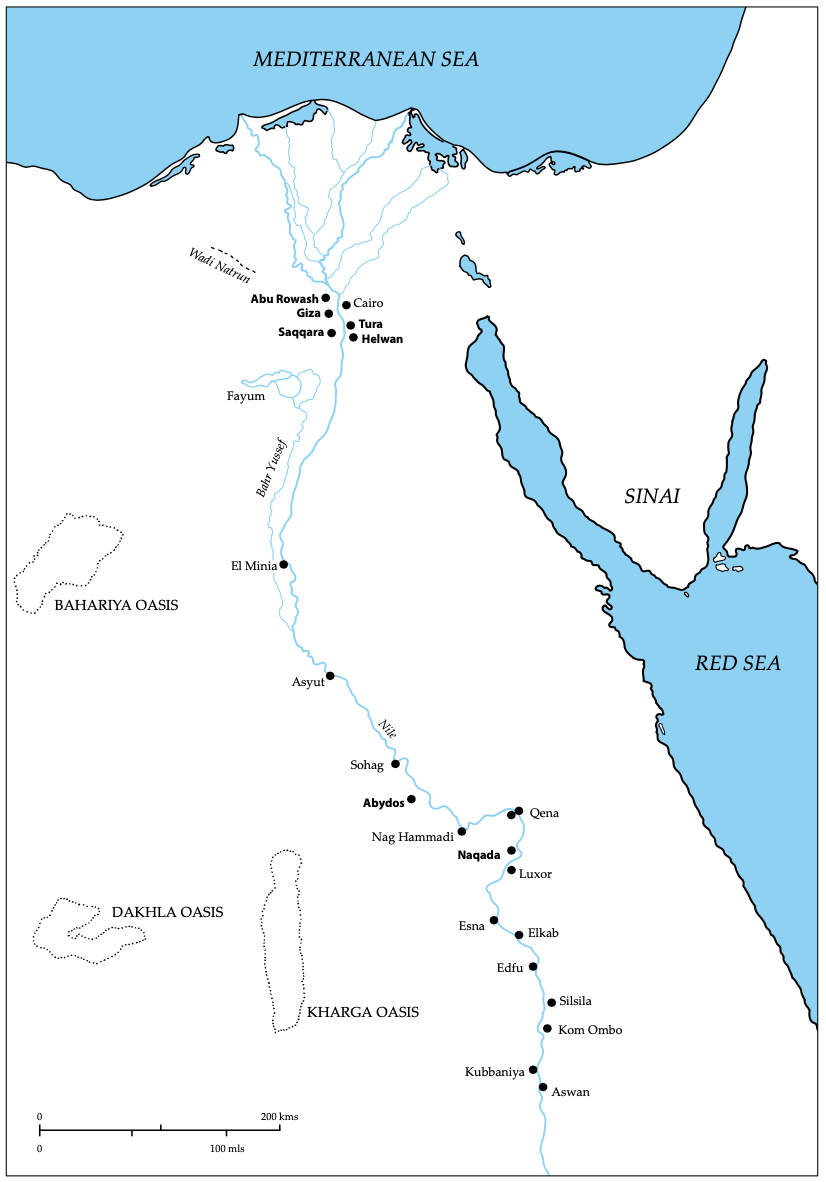
Figure 1: Map of Egypt with main find sites for inscribed labels, vessels and stelae in bold (after Spencer 1993: 19, fig. 6).
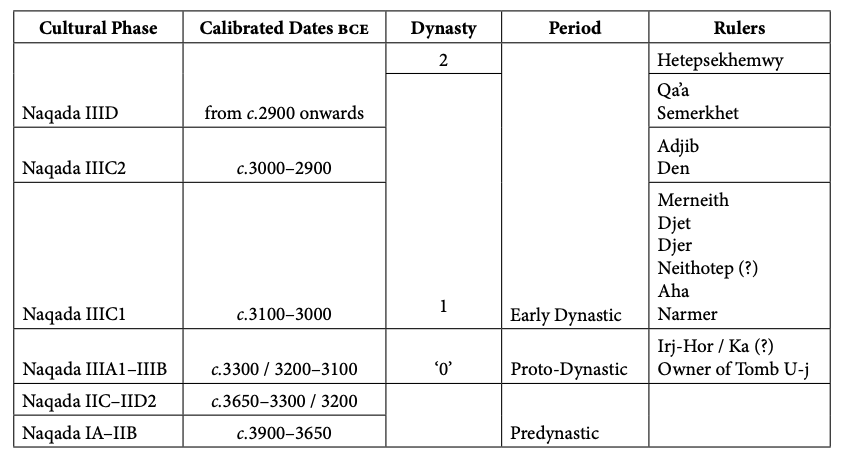
Table 1: Chronological chart (after Hendrickx 1996: 64; Wilkinson 2001 [1999]: 27).
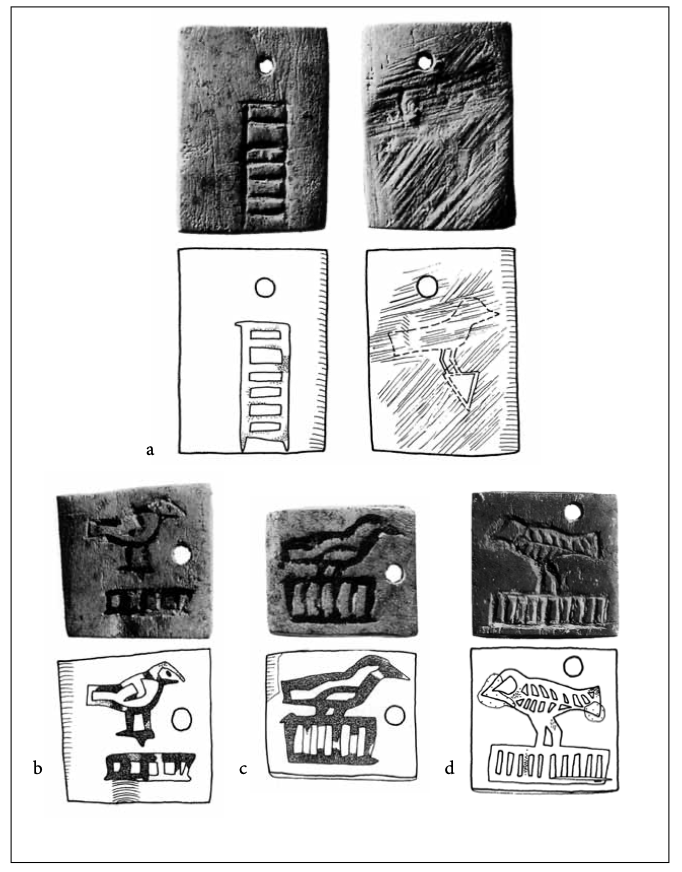
Figure 2: Inscribed bone labels from Cemetery U, Abydos dated to the Naqada IIIA1 phase. a) Label with ‘rectangular shape’ or possible ‘N39’ / ‘pool’ incised on one face and an erasure on the opposite face, the shape of ‘G5-s33(?)’ / ‘bird perched on triangular support’ still being discernible. h 1.25 cm; w 1.7 cm; th 0.15–0.2 cm. Provenance: Tomb U-j S. Ab K 834. Source No. 4396; b) Label bearing an abutting combination of ‘rectangular shape’ and ‘bird’. h 1.3 / 1.35 cm; w 1.5 cm; th 0.25–0.3 cm. Provenance: U-j 11. Ab K 654. Source No. 4348; c) Label bearing the non-abutting combination of ‘rectangular shape’ and ‘G5-s33(?)’ / ‘bird perched on triangular support’. h 1.5 / 1.6 cm; w 1.7 / 1.5 cm; th 0.1–0.2 cm. Provenance: U-j 11. Ab K 655. Source No. 4364; d) Label bearing an abutting combination of ‘rectangular shape’ and ‘bird’. h 1.5 cm; w 1.5 cm; th 0.25–0.2 cm. Provenance: U-j 11. Ab K 658. Source No. 4349. All Dreyer 1998. 2a: [t] 131, no. 156, [d] 133, fig. 81, no. 156, [p] pl. 34. no. 156; 2b: [t] 126, no. 108, [d] 127, fig. 79, no. 108, [p] pl. 32, no. 108; 2c: [t] 128, no. 124, [d] 127, fig. 79, no. 124, [p] pl. 32, no. 124; 2d: [t] 126, no. 109, [d] 127, fig. 79, no. 109, [p] pl. 32, no. 109). Courtesy Günter Dreyer and the Deutsches Archäologisches Institut Kairo.
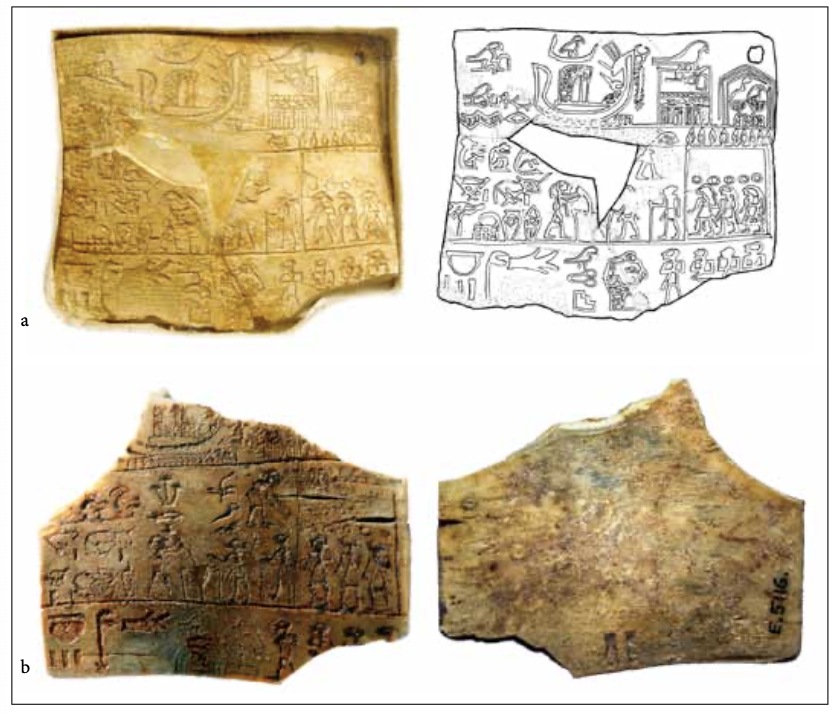
Figure 3: Two ivory labels showing an erasure in the lower left of the bottom register. Warping and colour due in part to exposure to high heat, probably during the firing of the tomb. a) Photograph and drawing of recto. h 4.8 cm; w 5.6 cm; th 0.2 cm. Provenance: Naqada, mastaba tomb attributed to Neith, chamber ‘γ’ (de Morgan 1897: [t] 161, 165, 167, 234, [d] 167, fig. 549). Source No. 0240. JE 31773. Author’s photograph, courtesy the Egyptian Museum, Cairo, drawing from Spencer 1993: 63, with permission Richard Parkinson); b) Photograph of recto and verso. h 3.5+ cm; w 4.5 cm; th 0.17–0.26 cm. Provenance: Naqada, near mastaba tomb attributed to Neith (Garstang 1905: 61, figs 2–3). Source No. 0241. E.5116. Author’s photographs, courtesy the Garstang Museum of Archaeology, University of Liverpool.
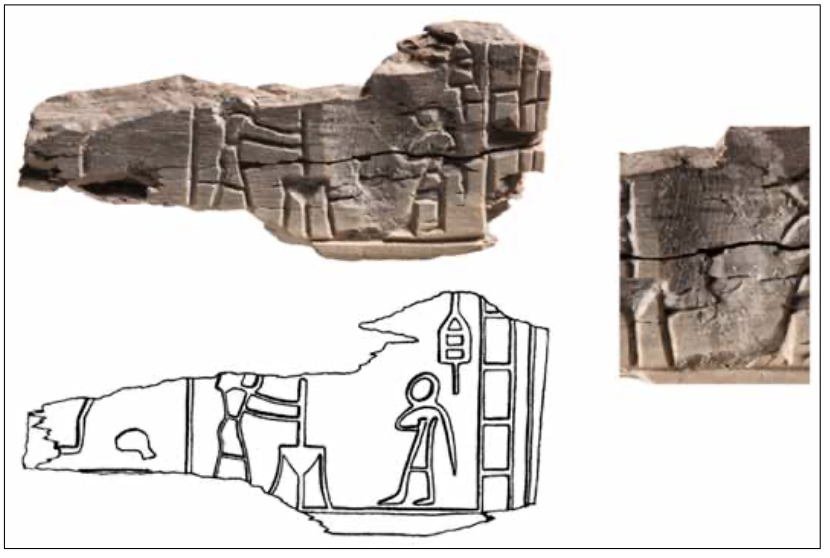
Figure 4: Fragment of an incised wooden label showing what appears to be an oil or wine pressing scene. The detail (right) shows that an image to the right of the ‘mortar and pestle’, possibly a ‘human figure’, has been erased (cf. Figure 3). h 1.78+ cm; w 2.31+ cm; th 0.41 cm. Provenance: Abydos, tomb complex Z attributed to Djer, subsidiary grave Z3 (Petrie 1900: 21). Source No. 0943. E.0078. Photograph and detail with permission © Royal Museums of Art and History, Brussels. Drawing from Petrie 1900: pl. 13, no. 5, courtesy of the Egypt Exploration Society.
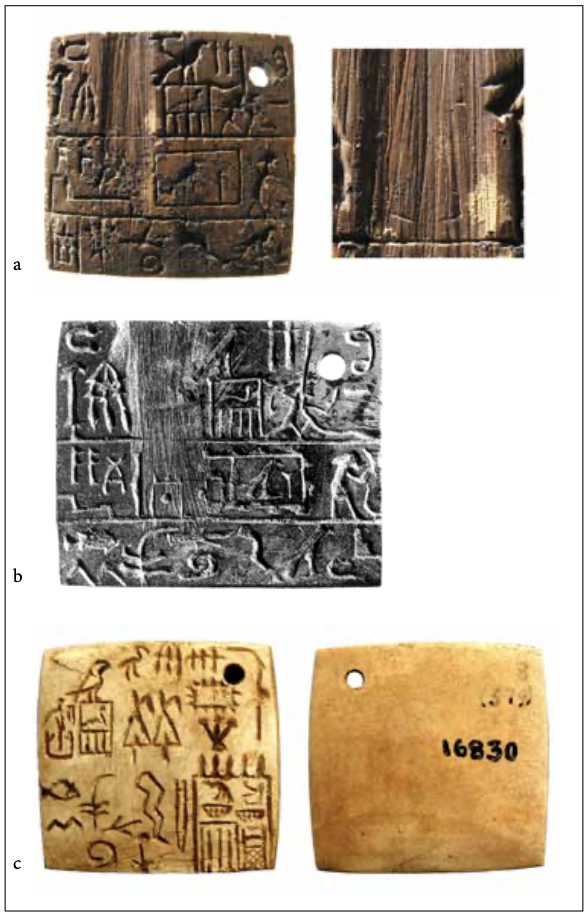
Figure 5: Incised labels bearing the PIs of Djet. a) Label (probably of elephant ivory, pers. comm. Günter Dreyer), showing erasure. h 2.95–3.05 cm; w 3.1 cm; th 0.33-0.38 cm. Provenance: Abydos, near tomb complex T in area T-NOOO (Dreyer et al. 2003: [t] 94). Source No. 4807. Ab K 2602. Photograph courtesy Günter Dreyer and the Deutsches Archäologisches Institut Kairo; b) Ivory label with an erasure in a location similar to 5a. Provenance: Abydos, fragments found during two seasons in areas T-NW + T-NOOO, northwest and northeast, respectively, of tomb complex T attributed to Den (Dreyer et al. 1998: [t] 162–163, [p] pl. 12a; 2003: [t] 93–94, [p] pl. 18f). h 3.15 cm; w 3.9 cm; th 0.35 cm. Source No. 4084. Ab K 2536. Photograph cour- tesy Günter Dreyer and the Deutsches Archäologisches Institut Kairo; c) Recto and verso of an incised and colour-infilled elephant ivory label. Provenance: Saqqara, tomb S3504, dated to the reign of Djet (Emery 1954: 3, 102–103, fig. 105). Source No. 986. JE 16830. Author’s photograph, courtesy the Egyptian Museum, Cairo.
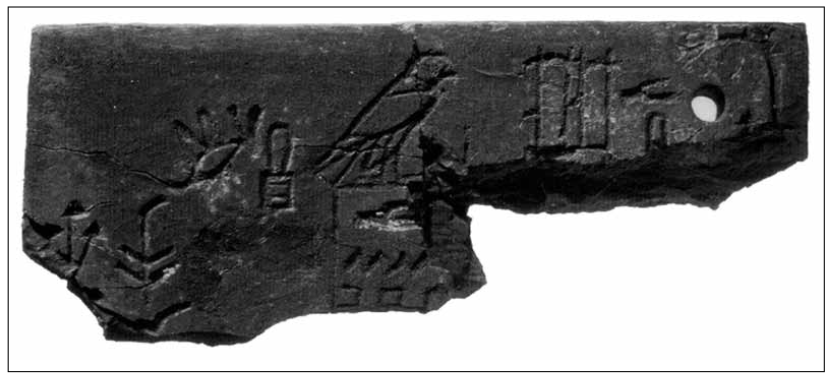
Figure 6: Incised label fragment (upper half) of wood bearing the PI of Den, a mid-1st Dynasty ruler. The imagery below the ‘S20’ / ‘seal on lanyard’ and ‘L2’ / ‘bee’ has been erased (cf. Figure 7–8). Provenance: Abydos, tomb complex T attributed to Den, Chamber S1 (Dreyer et al. 1990: [t] 80–81, [p] pl. 26a). h 2.7+ cm; w 6.9 cm; th 0.6 cm. Source No. 1372. Ab K 381. Photograph courtesy Günter Dreyer and the Deutsches Archäologisches Institut Kairo.
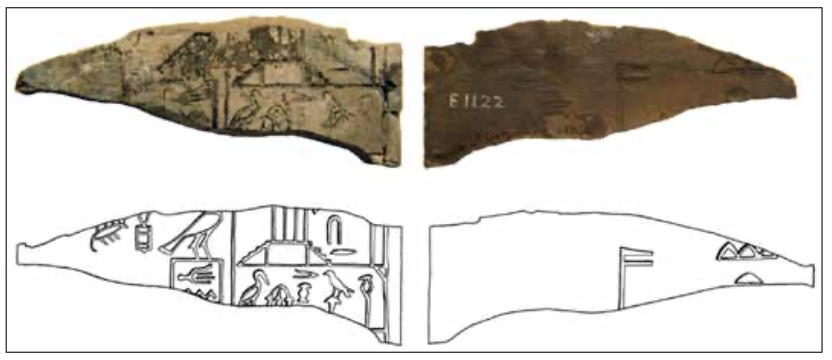
Figure 7: Incised label fragment of elephant ivory bearing the PI of Den. Imagery below the ‘S20’ / ‘seal on lanyard’ and ‘L2’ / ‘bee’ has been erased (cf. Figures 6 and 8). Provenance: Abydos, tomb complex T attributed to Den (Petrie 1900: [t] 21, [p] pl. 11, no. 5). Source No. 1249a–b. E.1122. Author’s photographs, courtesy the Ashmolean Museum. Drawings from Petrie 1900: [d] pl. 14, nos 12–12 A, courtesy of the Egypt Exploration Society.
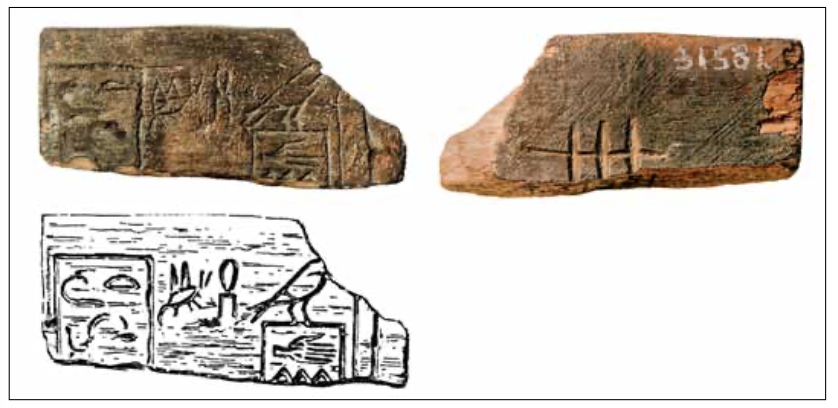
Figure 8: Incised label fragment of wood bearing the PI of Den. Imagery below the ‘S20’/‘seal on lanyard’ and ‘L2’ / ‘bee’ has been erased (cf. Figures 6–7). Provenance: Abydos, surface find. h 2.6+ cm; w 5.5 cm; th 0.3–0.7 cm. Source No. 1366. JE 31581. Author’s photograph, courtesy the Egyptian Museum, Cairo. Drawing from de Morgan 1897: 234, fig. 782.
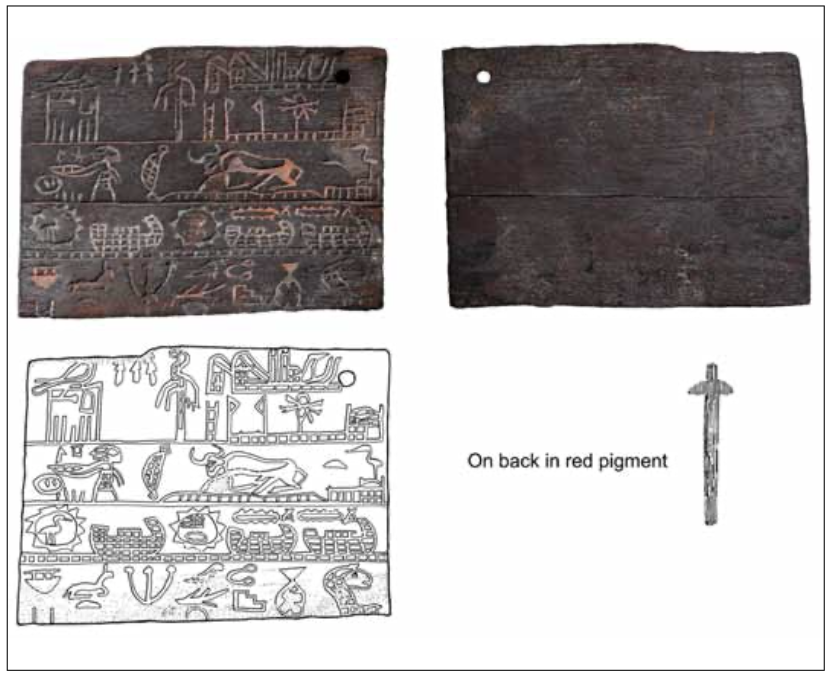
Figure 9: Wooden label inscribed using incision and red colour infill on the primary face, with applied red colour on the secondary face. Provenance: Abydos, tomb B 18 (Narmer) / B 19 (Aha) (Petrie 1901: [t] 21, 51, [p] pl. 3A, no. 5). h 6.79 cm; w 9.45 cm; th 0.71 cm. Source No. 0284a–b. E 9396. Author’s photographs, courtesy University of Pennsylvania Museum of Archaeology and Anthropology. Drawings after Petrie 1901: pl. 10, nos 2–3, courtesy of the Egypt Exploration Society.
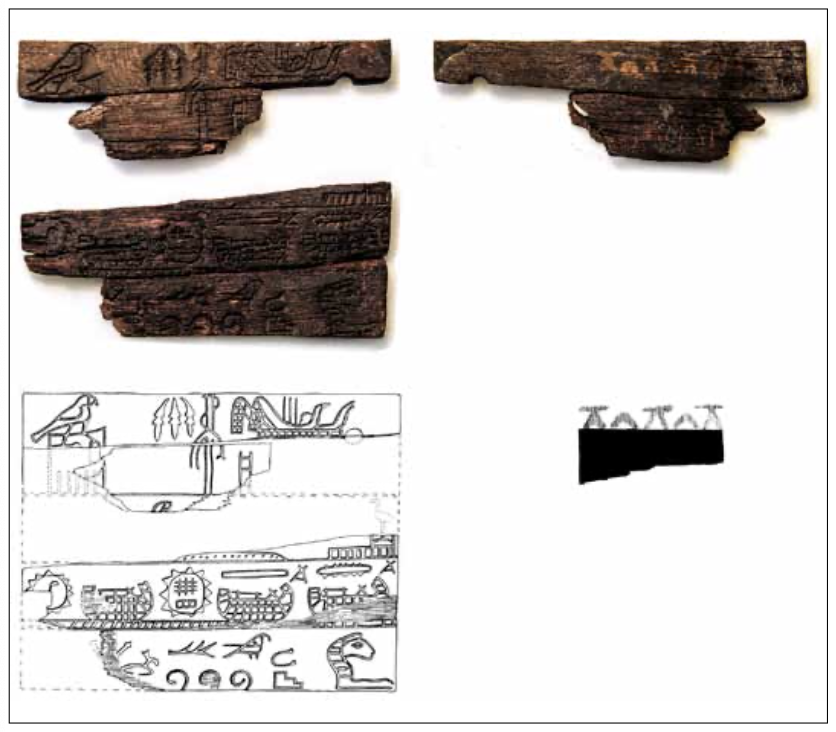
Figure 10: Fragmentary wooden label inscribed using incision on the primary face, with applied pigment on the secondary face (photography of full recto not permitted due to fragile condition). Provenance: Abydos, tomb B 18 (Narmer?) / B 19 (Aha?) (Petrie 1901: [t] 21, [p] pl. 3a, no. 6). h 5+ cm; w 9.6 cm; th 0.23–0.4 cm. Source No. 0283a–b. EA 35518. Author’s photograph, courtesy Trustees of the British Museum. Drawings from Petrie 1901: pl. 11, nos. 2–3, courtesy of the Egypt Exploration Society.
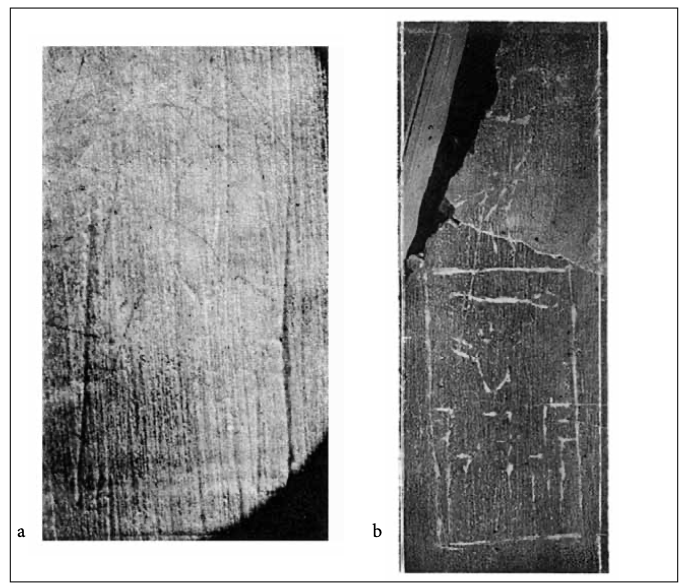
Figure 11: Details of stone vessels bearing erasures of the PI of Adjib. Provenance: Abydos, tomb complex U, attributed to Semerkhet, Adjib’s successor (Petrie 1900: [t] 20). Not to scale. Photographs from Petrie 1900: [p] pl. 6, nos 9 and 11, courtesy of the Egypt Exploration Society.
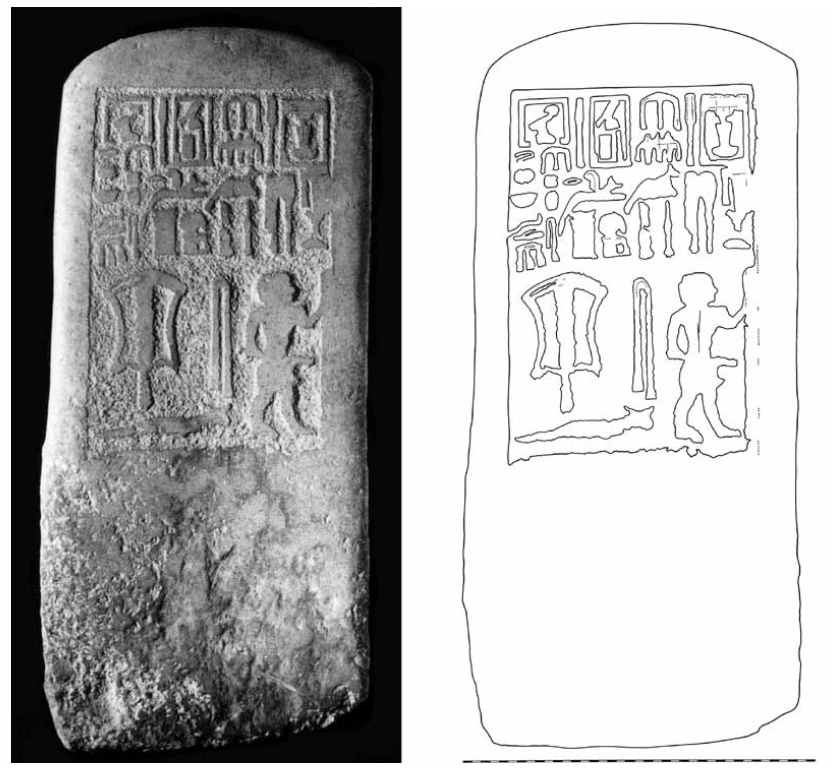
Figure 12: Limestone stele No. 48 with incomplete carving along the right side. Dated to the end of the 1st Dynasty. Provenance: Abydos, “[t]his lay in a chamber on the west of Qa’a” (Petrie 1900: [t] 26 and pl. 60, [p] pl. 36, no. 48, [d] pl. 30 [with red-brown drafting lines indicated] and pl. 31, no. 48; also Martin 2011: [t] 44, [d] 45, Stela 48, [p] pl. 14, Stela 48). h 84.2 cm; w 37.5 cm; d 8.5 cm. Source No. 1865. JE 34416. Egyptian Museum, Cairo. Photograph and drawing courtesy Geoffrey Thorndike Martin and Harrassowitz.
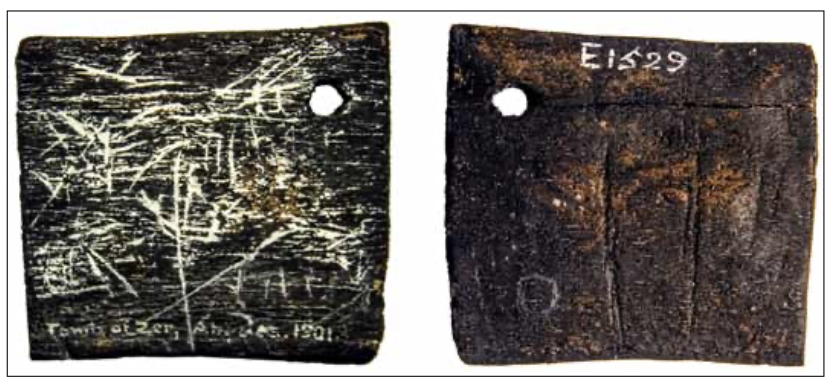
Figure 13: A wooden label showing what appears to be a roughly rendered inscription, subsequently scratched out (modern writing on the lower primary face in white ink reads, “Tomb of Zer, Abydos. 1901.”). And on secondary face marked ‘O’ in pencil. Provenance: Abydos, tomb complex O, attributed to Djer (Petrie 1901: [t] 24, [p] pl. 6a, no. 5). h 3.6–3.8 cm; w 3.8–4.1 cm; th 0.2–0.3 cm. Source No. 0643. E.1529. Author’s photograph, courtesy Ashmolean Museum.
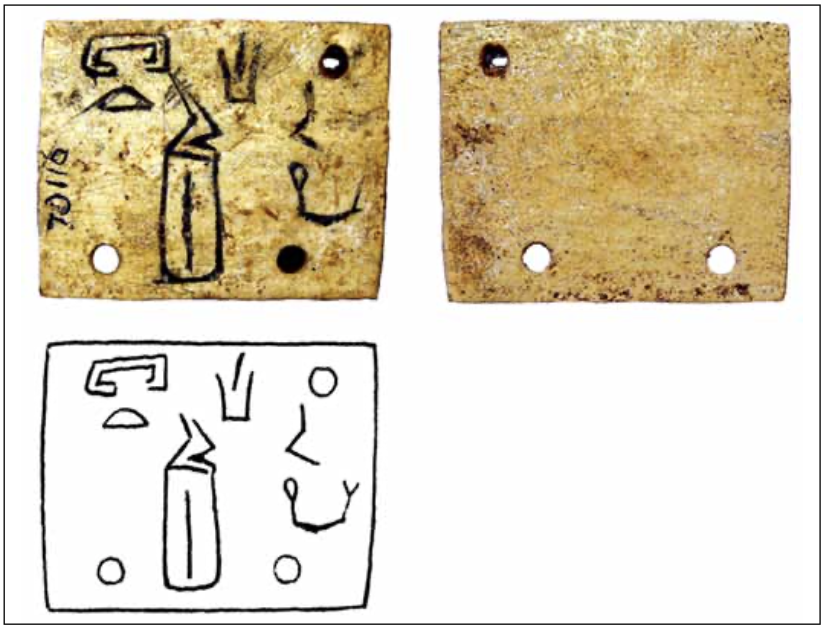
Figure 14: Incised ivory plaque showing the upper tip of the large central sign (‘s25’ / ‘bag’ [follow- ing Weill 1940: 222–223]) that has been scratched out. Provenance: North Saqqara, Tomb 3035. Dated to the 1st Dynasty reign of Djer? / Den (Emery and Sa’ad 1938: [t] 39, [p] pl. 17C (Cat. No. 413), [d] pl. 18C [Cat. No. 413]). h 2.6–2.61 cm; w 3.15–3.24 cm; th 0.15–0.29 cm. Source No. 1422. JE 70116. Author’s photograph, courtesy the Egyptian Museum, Cairo. Drawing from Emery and Sa’ad 1938: pl. 18B.

